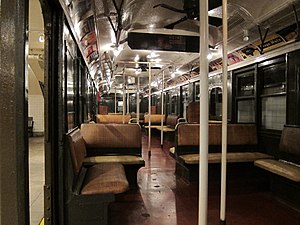This article needs additional citations for verification. (October 2015) |
| AB Standard | |
|---|---|
 AB Standard #2392 at the Brighton Beach station on June 27, 2015. | |
 Interior view of AB Standard car #2204 | |
| In service | 1915–1969 |
| Manufacturer | American Car and Foundry Company Pressed Steel Car Company |
| Constructed | 1914–1922, 1924 |
| Entered service | June 22, 1915 |
| Refurbished | 1958–1960 |
| Scrapped | 1960–1969 |
| Number built | 950 (2 additional cars delivered with the 1919 group to replace cars damaged the previous year) |
| Number preserved | 5 |
| Number scrapped | 945 |
| Successor | R27 R30 R32 R40 R42 |
| Formation | See letter designations below |
| Fleet numbers | 2000–2599 (ACF motors) 2600–2899 (Pressed Steel motors) 4000–4049 (Pressed Steel trailers) |
| Capacity | 260: 78 (seated) 182 (standing) |
| Operators | Brooklyn Rapid Transit Company Brooklyn–Manhattan Transit Corporation NYC Board of Transportation New York City Transit Authority |
| Specifications | |
| Car body construction | Riveted Steel |
| Car length | 67 ft 6 in (20.57 m) |
| Width | 10 ft 0 in (3,048 mm) |
| Height | 12 ft 1+1⁄8 in (3,686 mm) |
| Floor height | 3 ft 1+1⁄8 in (0.94 m) |
| Doors | 6 |
| Maximum speed | 45 mi (72 km) per hour |
| Weight | Motor car: 96,320 lb (43,690 kg) Trailer car: 80,162 lb (36,361 kg) |
| Traction system | Motor car: Westinghouse ABF 214 or 480, with Westinghouse 27B master controller, using GE 248A motors (140 hp each). 2 motors per car (1 per truck). Trailer car: None |
| Power output | 140 hp (104 kW) per traction motor |
| Auxiliaries | Edison B4H (32 Volt) battery with 24 cells. Battery charged primarily by air compressor and trickle charged by car's main lights. |
| Electric system(s) | 600 V DC Third rail |
| Current collector(s) | Top running Contact shoe |
| AAR wheel arrangement | Motor car: 1A-A1 Trailer car: 2-2 |
| Bogies | A-55 Maximum Traction Truck |
| Braking system(s) | WABCO Schedule AMUE with UE-5 universal valve, ME-23 brake stand, and simplex clasp brake rigging. Air provided by WABCO D-3-F Compressor. |
| Coupling system | WABCO H2C |
| Track gauge | 4 ft 8+1⁄2 in (1,435 mm) standard gauge |
The AB Standard was a New York City Subway car class built by the American Car and Foundry Company and Pressed Steel Car Company between 1914 and 1924. It ran under the operation of the Brooklyn Rapid Transit Company (BRT) and its successors, which included the Brooklyn–Manhattan Transit Corporation (BMT), the New York City Board of Transportation, and the New York City Transit Authority (NYCTA). The cars were designed following the signing of the Dual Contracts, which called for a major expansion of the BRT. A total of 950 cars were built.
In their earliest days of service, operating crews frequently called them Steels to distinguish them from the wooden BU elevated cars. However, these cars were most commonly referred to as BRT Standards, BMT Standards, or simply Standards. Train crews and the car shop departments often referred to them as 67-foot cars, AB-types, or most frequently ABs.[not verified in body] For their time, the cars introduced a significant number of improvements to urban rapid transit. The AB Standards were slowly retired in the 1960s, last running in 1969. Several AB Standards have been preserved.